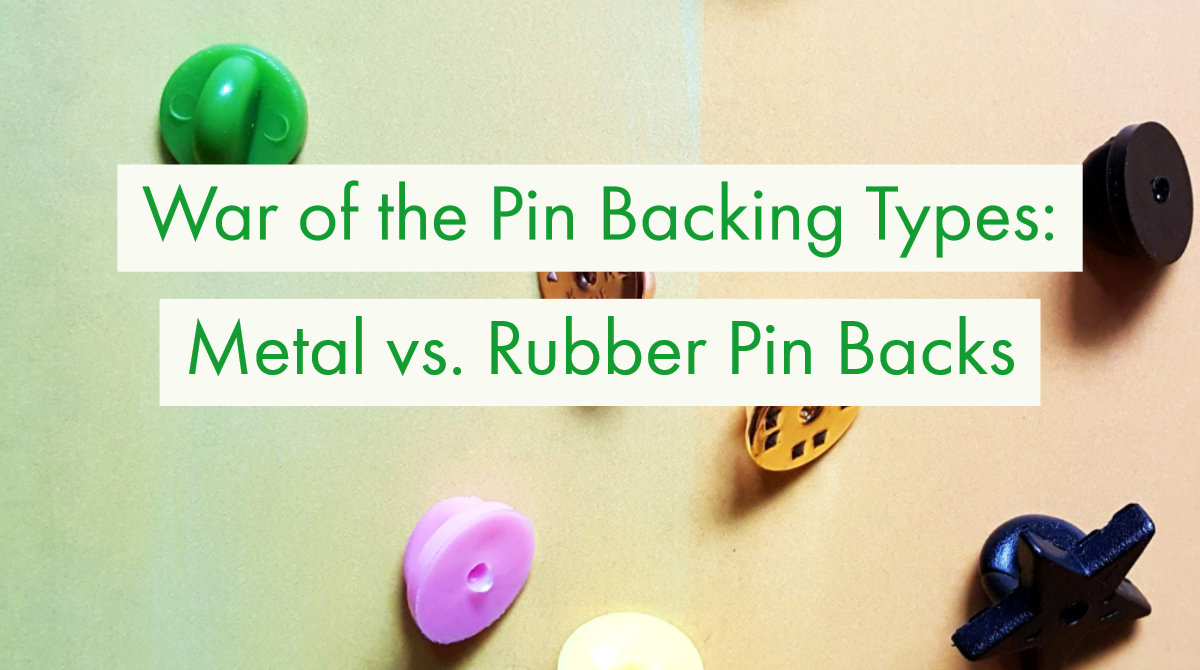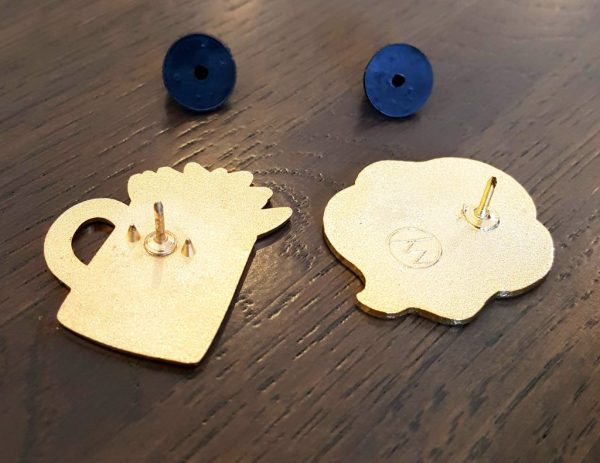
It’s time for my first post of June and I’m scrambling to get it done on time. So instead of the lengthy “Starting an Art Business part 4” post I’ve been working on, I’m giving you all a little insider pin knowledge. Today we’re talking about pin backs.
Those of you with no interest in enamel pins can come back next week.
Pin Backs? Who Cares?
There’s a bit of a rivalry going on in the pin community. (Not really.) It’s been going on for centuries. (Maybe a few years at most?) This division is comparable to the likes of age-old conflicts like:
DC or Marvel?
Subs or Dubs?
Dogs or Cats?
Normal people coffee or Decaf?
Toilet paper roll facing up or Down? (The answer is up, you monsters.)
And that conflict is…
Metal Pin Backs vs. Rubber Pin Backs
If you’re a pro pin collector (or creator), bear with me while I drop some Pin 101 knowledge. Enamel pins typically have one or two posts with some type of back or clasp to secure it to a surface. But the question is, do you go with rubber or metal pin clasps?

Metal backs are probably the most well-known to the general public. They’re also called butterfly clasps/clutches and have those two little tabs you have to squeeze together to take the clasp off. But we all know those two tabs aren’t particularly secure. Sometimes you can rip a metal clasp right off without touching the tabs. Or was that just my childhood experience?
[]
Rubber backs, on the other hand, are a very simple piece of rubber with no intricate workings. All they require is a simple pull or push.
The first enamel pins I bought had rubber backs. Initially, I thought they were just cheaper to produce. But when I started making pins for myself, I found that no manufacturer (that I’ve come across so far) charges a different price for rubber or metal backs.
I ended up snooping, asking around, and Googling to find out, what’s the difference between rubber and metal backs? Is one better than the other?
Meanwhile, being already biased toward rubber and finding insufficient information online, I chose rubber backings for my first pin and pin set. All of my current pins have rubber backs.
Which is Better: Metal or Rubber backings?
I do have opinions on this topic now, not just a bias toward my first type of pin backs. But spoiler alert, the difference between metal and rubber backs comes down to personal preference.
The majority of pin makers I’ve purchased from use rubber. But I’ve heard others express a strong preference for metal. A few creators offer both. And while one isn’t definitively better than the other, there are definite pros and cons to discuss.
Metal Pin Backs
Other names: butterfly clasp, metal clutch, butterfly clutch, military* pin back, military butterfly clasp

Pros:
- Metal backs on metal pins look more uniform
- Butterfly clasp provides a slight lock
- Better for securing pins on thicker material
- Can customize metal color
Cons:
- Doesn’t provide a tight fit or secure lock
- Butterfly tabs can get caught in hair and clothing
- Metal colors are limited
Summary:
Metal pin backs have the noticeable benefit of looking more uniform. Some people view them as more aesthetically pleasing. Metal backings can be customized to a limited extent by metal color. I have butterfly clasps in gold, silver, and rose gold. But typically no one will see the clasp except you. On the other hand, you do need to deal with the possibility of your clasp getting caught in hair, clothing, or scratching your skin.
The more important consideration for pin backs is security. Some people complain about how easily their metal pin backs have fallen off, while others report having no problems. Compared with rubber backs, butterfly clasps have a looser fit; they’ll never be completely flush against the pin needle.
However, metal pin backs tend to be better if you’re frequently removing and replacing pins, like me. While the butterfly clasp mechanism can get worn down, the back ultimately holds its shape better than rubber, which will stretch with extended use.
Rubber Pin Backs
Other names: PVS rubber pin back (this one’s pretty straightforward)

Pros:
- Tight fit
- Very secure on thin or textured fabric
- Smooth surface is skin-friendly
- Highly customizable
- Better grip
Cons:
- Harder to secure on a thick surface
- Loosens over time and with movement
- Security varies by quality
Summary:
In general, rubber pin backs provide a tighter fit. The hole in the pin back is made to fit your pin post perfectly. Some rubber pin backs are so tight that I’ve had trouble removing them at first. But the key phrase here is “at first.” Rubber stretches over time, leaving you with a looser fit, the more you remove and replace your pin.
And although rubber backs are pretty secure, they can also loosen if you have your pin on a surface that sees a lot of movement, like a lanyard or tote bag. But if you plan to leave your pin on a surface permanently, your rubber pin back is less likely to stretch. The rubber surface is also durable and won’t get caught on hair or clothing.
Another big draw of rubber pin backs is customizability. You can choose different colors and even special shapes. I’ve seen heart- and star-shaped pin backs and of course, Disney pins have rubber backs in the shape of Mickey Mouse heads.
Finally, I’d add that rubber pin backs have the benefit of a tighter fit on fabric. All pins have one or two sharp nubs next to their pin post. When a pin is pushed completely flat against its backing card, you’ll see a little indent next to the hole from this nub. In many rubber pin backs, you can also see a faint indent or two from these “nubs.” (Sorry if “nub” sounds weird–I don’t know what else to call it.)
To get a more secure fit, from your rubber pin back, you can press your pin tightly against a fabric surface so that the nub also catches the fabric. Then press the rubber back as tightly against the back as possible to secure with both the post and the nub. If this makes no sense, hopefully these pictures will help:


Anyway, the point is that rubber backs can give a really secure fit.
What About Locking Pin Backs?
There’s another type of popular pin back on the market. No post on the different types of pin backs would be complete without it. They’re locking pin backs.
In the end, rubber and metal pin backs don’t have a significant difference in security. It’s possible to lose pins with both backing types. So collectors turn to locking pin backs. I’m not focusing on this type of pin back because a.) I’ve never used them and b.) they’re in an entirely different league. But I’ll take a moment to share what I know.
Locking pin backs are also called locking clutches, deluxe pin backs, spring-loaded clutch backs, or military pin keepers.
*I would assume these are the true “military pin backs” but I’ve seen people refer to both regular butterfly clasps and locking pin backs as “military.” So just make sure you’re seeing a picture before you purchase any “military” pin backs.
Locking pin backs come in two variations: flathead and ball head pin backs. They look exactly how they sound and function in pretty much the same way. In order to lock your pin into place, these pin backs have a spring, which you release by pulling the top (flat or ball) up while pushing the bottom of the back down at the same time. If this sounds confusing, here’s a quick YouTube video and one with a longer explanation.
Some locking pin backs require you to open the spring whenever you want to put the clutch on or off. Others just need a firm push to put on and a squeeze only when you want to take the pin back off. Apparently there’s a bit of a learning curve; you may need a few tries to get used to releasing these pin backs.
Locking pin backs are more costly and in most cases, you’ll need to purchase them separately from your pins. I definitely plan to try locking pin backs someday…but for now, I’m spending my money on new pins.
(And if you’re thinking I sure had a lot to say about locking pin backs for someone who’s never used them, well, my cheap research skills are top-notch. I once had a sketchy job writing product reviews for items I’ve never even touched. Don’t trust everything you read online folks.)
Which Do I Prefer: Rubber or Metal Pin Backs?
Although I’ve only used rubber backs for my pins so far, I’ve recently been tempted by metal. So much so that I’ve ordered butterfly clasps for my next batch of pins (currently in production). I’m not set on metal, but recently I’ve come across a problem with my rubber pin backs.
I move my pins around. A lot. Especially my sample set of succulent pins. I’m constantly sticking them in different places to take pictures. As a result, the backings have gotten noticeably looser.
Meanwhile, I have some pins from a friend that use metal pin backs. To be honest, these butterfly clasps are a little difficult to remove. I have to pinch the butterfly tabs and jimmy it around a bit to remove them. But those pin backs are SECURE. Even with the amount of traveling these pins have done from one surface to another, these pins still stick.
So forget my worries about branding and consistency; I’m testing out metal pin backs. Maybe in a few months time, I’ll have a clear favorite, but for now, I’m still on the fence.

Do you have strong opinions on pin backs? This is a super serious topic! Feel free to fight it out in the comments!